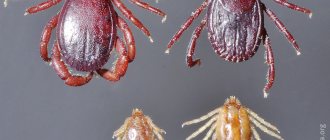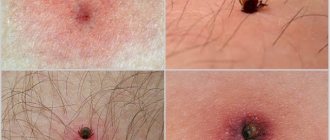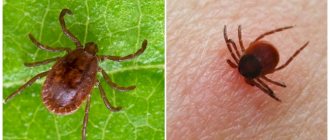Tick-borne encephalitis
Tick bite
Borreliosis
8169 11 November
IMPORTANT!
The information in this section cannot be used for self-diagnosis and self-treatment.
In case of pain or other exacerbation of the disease, diagnostic tests should be prescribed only by the attending physician. To make a diagnosis and properly prescribe treatment, you should contact your doctor. We remind you that independent interpretation of the results is unacceptable; the information below is for reference only.
Ixodid tick research: indications for use, rules for preparing for the test, interpretation of the results and normal indicators.
Indications for the purpose of the study
The indication for performing the study is the attachment of a tick to the human body.
Ixodidae) are of greatest epidemiological importance
).
Infections transmitted by ixodid ticks are characterized by spring-autumn seasonality from April to October, however, in regions with warm climates, year-round activity of ixodid ticks is observed. Risk groups for the incidence of infections transmitted by ixodid ticks are residents of urban and rural areas who visit tick habitats. Transmission of infectious agents occurs when infected ticks attach themselves to the human body.
Infections transmitted by ixodid ticks include tick-borne viral encephalitis, ixodid tick-borne borreliosis, tick-borne human granulocytic anaplasmosis, human monocytic ehrlichiosis and others (Q fever, Crimean hemorrhagic fever, tularemia, rickettsiosis).
The causative agent of tick-borne encephalitis
— RNA-containing virus of the genus
Flavivirus
. The incubation period of the disease is, as a rule, 7–14 days from the moment of tick bite, but can last up to 25 days. The infection affects the cells of the brain and spinal cord with the subsequent development of paresis and paralysis.
Identification of the causative agent of tick-borne viral encephalitis in a tick allows for timely emergency prevention of infection. If a positive result is obtained, emergency administration of a specific immunoglobulin is indicated - no later than 72 hours from the moment of the bite. The maximum effectiveness of the drug is observed when it is administered during the first day after the bite.
The causative agent of Lyme disease
- spiral-shaped bacterium of the genus
Borrelia
. The disease develops in 20% of cases after sucking on a tick infected with Borrelia. In 50-80% of patients, local skin inflammation is observed - tick-borne migratory erythema (redness), the diameter of which does not exceed 5 cm. When spreading through the blood, Borrelia affects internal organs, cells of the nervous system, as a result of which meningitis, meningoencephalitis, radiculoneuritis, neuritis can develop cranial nerves.
The causative agent of human granulocytic anaplasmosis
- the bacterium
Anaplasma phagocytophilum
, which infects granulocytes - white blood cells containing granules (neutrophils, eosinophils, basophils). Infection occurs through the bite of a tick infected with bacteria called anaplasma.
Symptoms of the disease include prolonged fever, weakness, headache, sweating, cough, nausea, vomiting, diarrhea, muscle and joint pain. The lymph nodes become enlarged, and damage to the kidneys, liver, and spleen may occur. Inflammation of the membranes of the brain and spinal cord is less commonly diagnosed. The incubation period averages 14 days.
The causative agents of monocytic ehrlichiosis
are bacteria belonging to the genus
Ehrlichia
. They enter the human body with tick saliva, enter the blood through the lymphatic tract and begin to multiply in the cells of the inner surface of blood vessels, in white blood cells - monocytes. After the cell is destroyed, microorganisms leave it and infect others. Internal organs (liver, central nervous system, bone marrow, skin) are affected with the development of infectious granulomas. The clinical picture of ehrlichiosis is similar to granulocytic anaplasmosis.
Human granulocytic anaplasmosis, monocytic ehrlichiosis and borreliosis are indications for antibiotic therapy. With timely detection of the disease and treatment, the prognosis is favorable.
Virus analysis price
Some insurance policies cover the cost of laboratory tests. But most often the research is carried out on a paid basis.
The cost of the service depends on the type of establishment. In government institutions, the cost of the study is about 300–400 rubles. In private clinics it is in the range of 400–600 rubles. This is the cost of testing to detect one virus. Ticks can carry several diseases - encephalitis, borreliosis and a number of others. Therefore, a comprehensive examination will cost 800–1,200 rubles.
Ticks carry deadly diseases that quickly infect the blood and require prompt treatment. If you get tested on time, you can receive qualified help on time and have a mild form of the disease.
Preparation for the procedure
If you find an attached tick, you must go to a trauma center to remove it from the body.
If this is not possible, the tick should be removed yourself. To do this, you need to intercept the tick's body with gauze-wrapped fingers or tweezers strictly perpendicular to the surface of the body, as close as possible to its oral apparatus. Then, turning the tick's body around its axis, remove it. It is not recommended to lubricate the bite site and the tick itself with oil. The tick with a piece of damp cotton wool must be placed in a tightly closed container (a special container with a lid for studying biomaterial, a jar, a test tube, etc.). Ticks taken from different people should not be placed in the same container. Disinfect the wound on the skin with an antiseptic (alcohol, iodine, brilliant green), and wash your hands thoroughly with soap after removing the tick. Deliver the container with the tick to the nearest medical office on the day of removal. Currently, you can purchase special devices for removing ticks, which are sold in pharmacies.
Before examination, live ticks can be stored in the refrigerator at +2 +8°C for up to 1 month. Examination of a dead tick is allowed if it is stored after removal in the refrigerator at a temperature of +2 +8°C for no more than 5 days. Taking into account the risk of developing tick-borne encephalitis and the duration of the study (up to 3 working days), it is better to submit the tick for examination on the day it is removed from the body.
Bitten by a tick. Why check the parasite and get tested yourself?
We'll tell you where and what tests you need to take to understand whether a tick has infected you or not.
“I remember when I was little, none of my friends and relatives went to hospitals to remove a tick and check it for infection. And they didn’t really think that there could be any consequences from this bite. Well, he bit and bit, mosquitoes over there bite too. And now all experts advise having the tick that bit you tested, and checking yourself as well. Why is this being done?
Ticks have become more active with the warming - in the Kirov region, the first bites of these parasites were registered in the beginning of April. Particular care should be taken in May-June - this is the time when their activity peaks, although ticks will pose a threat to humans until September.
Ticks can be carriers of several dozen infections, the main ones being tick-borne encephalitis (a disease of the nervous system that can lead to serious complications, including death) and borreliosis (Lyme disease). A successful outcome of the disease depends on timely prescribed therapy. That is why, after a tick bite, it is important to establish the fact of infection with a particular infection.
On this topic
How to recognize that your thyroid is not normal?
7665
In order to promptly recognize infection with one of the more than 50 viruses that ticks carry and begin treatment, the parasite must be caught and submitted to a laboratory to identify infectious agents.
At the same time, doctors do not recommend removing ticks from yourself using traditional methods; it is better to go to a medical facility. If you still decide to get rid of the parasite yourself, handle it carefully and avoid damaging the abdomen. If the tick bursts during the removal process, the chances of infection entering the bloodstream will increase many times over.
In addition, to confirm a diagnosis, identify a disease, or monitor the effectiveness of treatment, tests are performed on the patient himself. In modern laboratories, tests are carried out for specific antibodies to tick-borne encephalitis and borreliosis of two types of antibodies - IgM and IgG. The presence of substances of the first group in the blood indicates the acute stage of one or another disease, and the second are characteristic of previously suffered diseases or vaccinations against them.
— It is important to remember that specific antibodies to tick-borne encephalitis and borreliosis viruses are detected in the bloodstream only on the 10-14th day after the bite. In order not to throw money away, it is recommended to undergo laboratory tests no earlier than this period, so that the immune system has time to “work off” the threat. You need to hurry if there are clinical signs of the disease. For example, with Lyme disease, the skin suffers: at the site of the bite, the so-called erythema migrans appears - a red spot that increases in size, notes the INVITRO laboratory.
All of the above analyzes and tests can be taken in the independent INVITRO laboratory. Two medical laboratory offices are located right in the city center, they are conveniently accessible from anywhere in Kirov:
Two medical laboratory offices are located right in the city center, convenient to reach
- INVITRO on Moskovskaya, 23
- INVITRO on Vorovskogo, 50 (next to the Colosseum cinema):
About the main thing - briefly:
- Ticks can be carriers of deadly infections.
- First of all, ticks need to be checked for tick-borne encephalitis and borreliosis.
- Typically, ticks are submitted to the laboratory, but tests are also performed on the patient himself to confirm the diagnosis, identify the disease, or monitor the effectiveness of treatment.
- It is better for the patient to take a test to determine the virus in the blood 10-14 days after the bite.
- Analyzes and tests can be carried out in the INVITRO medical laboratory: on Moskovskaya, 23 and on Vorovskogo, 50.
*Affiliate material
Where to submit a tick?
It is often at this stage that the main problems arise. The thing is that a person who has encountered a tick bite for the first time may simply not know where to turn in such a situation. There are several options here. In order to properly remove the bloodsucker, it is best to consult a surgeon. A specialist will not only remove the tick without the risk of complications, but will also tell you where to go next with it.
Most often it is recommended to contact the SES. There must be special equipment with which you can determine whether an insect is a carrier of a dangerous disease or not. If your locality has a Rospotrebnadzor office equipped with a special laboratory, you can take the bloodsucker there.
Experts strongly recommend that you hurry up and go to the laboratory. This is important not only because the victim of a tick bite can be given an injection that will prevent the development of a dangerous disease, but also because of the possibility of making a correct diagnosis. If the tick stays in the jar for more than a day, it may die. In such a situation, identifying some viruses will be difficult.
If the victim of a tick bite lives in a large city, then there will most likely be many private laboratories.
They accept orders for examination of blood-sucking insects without waiting in line and complete the work very quickly. But in non-state laboratories, testing for tick-borne encephalitis will be paid. As a rule, its cost ranges from 500 to 1000 rubles. You shouldn't skimp on your health. If there is a private laboratory nearby where you can submit a tick, you should use its services. The sooner the danger posed by an individual attacking a person is determined, the higher the person’s chances of escaping with only a slight fright.
If the tick analysis shows the presence of encephalitis, the victim is given an injection. This is a special vaccine that significantly increases the body’s resistance to the virus.
How to save a tick?
The removed parasite should be placed in a container with a tight lid, along with a cotton swab moistened with water, and placed in the refrigerator. It is not recommended to store the container for longer than 24 hours. For microscopic analysis, it is advisable to deliver the tick to a medical facility alive. Even parts of the bloodsucker can be used for the PCR method, but this diagnostic method is used infrequently.
Advice. If it was not possible to preserve the parasite, it is recommended to submit its remains for analysis as quickly as possible. The DNA required for diagnosis is retained in the tick's body for no more than 3 days.
When contacting the laboratory, you should clarify the possibility of simultaneous testing not only for encephalitis, but also for borreliosis. Since the donated parasite will not be returned, you will not be able to take it to another facility for re-testing.
Ticks
Many people know about the danger of “picking up” a tick in the spring and summer in nature, especially in the forest. What precautions should you take and how to protect yourself and your loved ones?
Something to remember: Ticks are not always carriers of disease - most of their bites are harmless, but some can carry various diseases. In addition, a tick bite can cause an allergic reaction.
The most favorite places for ticks to hunt are wet places: forests, ravines, roadsides, and this is especially true, since there are plenty of them in Moscow and the immediate Moscow region. Therefore, if you decide to take a walk, you must:
- Cover your arms, legs and head with clothes. It is especially important to cover the legs, because ticks often wait for their prey by climbing on grass stems or low shrubs. It is interesting that ticks are practically deprived of vision, but they have an excellent sense of smell; they can smell the “victim” from a distance of 10 meters. Therefore, they are found 10-15 times more often on roadsides than in the forest, where there are fewer targets for attack.
- Use insect repellents.
- Be sure to keep an eye on your pets. Cats and dogs can carry ticks on themselves. If the tick has not managed to get to the animal’s skin through the fur, it can easily jump onto you.
- It is necessary to examine yourself, children and animals after a walk. The tick takes time to attach itself to the victim. You may well be able to detect it earlier. After it hits an open area of the body, it begins to look for a place to suction. The most favorite places for flares are the armpits, groins, scalp and ears.











